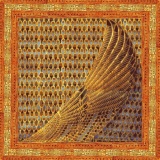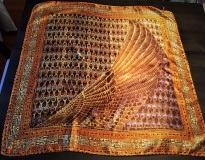- Scarves
- >
- King Tutankhamun Falcon Feather and Golden Band Scarf
SKU:
King Tutankhamun Falcon Feather and Golden Band Scarf
$45.00
$40.00
$40.00
On Sale
Unavailable
per item
Scarves are no longer simply a square or long narrow strip of material worn for warmth round the neck or tied round the head. Covering the head had religious connotations among the Hindus, Jews, Christians, Parsis and Muslims. For many years Indian sari-pallav or the dupatta or odhani has served this purpose.
But scarves have left behind the peasant-inspired look and have crashed onto the beaches, in colleges, evening out, day-time casual wear and the fashion magazines. They are in vogue and, along with bags, shoes, belts and jewelry, have become the accessories of the moment. Our designs have a blend of contemporary elements with the feel of the ancient designs relating untold tales. This design is taken from the Golden Bands that were around King Tut Mummy. The bands were made of beaten gold plaques which were inscribed with religious texts. The cartouche reads: Tutankhamon, Ruler of Heliopolis tut-ankh-amun heka iunu. Under the kings hands on the coffin the goddesses Nekhbet and Wadjet, spread their wings protectively around the upper part of the royal body. Each of them grasp in their talons the hieroglyphic sign for "infinity”. Under the kings hands on the coffin the goddesses Nekhbet and Wadjet, spread their wings protectively around the upper part of the royal body. Osiris were routinely added to the decoration of the coffin walls in order to provide a ring of protection around the king. Egypt is our window to humanity's distant past and in understanding its history, we find mankind's greatest glories and achievements, as well as his often repeated mistakes. We may follow along with the building of empires, only to see them collapse again and again. We find great men and rulers of renowned, but we often also see their ultimate demise. We learn about religion, its evolution and, as the world grows older, its replacement with newer religions. Yet, the ancient Egyptian religion has never really completely died out. Even today, many Egyptians continue customs, including some aspects of religion, held over from thousands of years ago. In fact, throughout the world, aspects of the ancient Egyptian religion, particularly funerary, continue to make an impact on our modern lives. The designs of the neckwear are based on elements found on the coffins of king Tutankhamen. There is probably no more famous group of artifacts in the world then those associated with the discovery of young King Tutankhamen's tomb. Tutankhamen died as young as 16 or 17 years of age. He was probably a son of King Akhenaton by one of his secondary wives. His wife Ankhesenamun was daughter of Akhenaton and Nefertiti. Tutankhamen came to the throne as a young child and ruled for about nine years under the regency of Vizier Ay and the strong influence of the army commander Horemheb. The main events of his reign were to move the capital of Egypt back from El-Amarna to Memphis and to begin the transition from the monotheistic cult of Aton created by Akhenaton back to the polytheistic religion of Egypt with Amun-Ra again as the main God.






